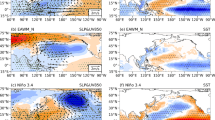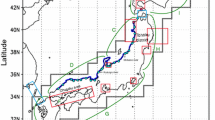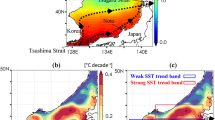Abstract
The availability of high-resolution atmospheric/ocean forecast models, satellite data and access to high-performance computing clusters have provided capability to build high-resolution models for regional ice condition simulation. The paper describes the implementation of the Los Alamos sea ice model (CICE) on a regional scale at high resolution. The advantage of the model is its ability to include oceanographic parameters (e.g., currents) to provide accurate results. The sea ice simulation was performed over Baffin Bay and the Labrador Sea to retrieve important parameters such as ice concentration, thickness, ridging, and drift. Two different forcing models, one with low resolution and another with a high resolution, were used for the estimation of sensitivity of model results. Sea ice behavior over 7 years was simulated to analyze ice formation, melting, and conditions in the region. Validation was based on comparing model results with remote sensing data. The simulated ice concentration correlated well with Advanced Microwave Scanning Radiometer for EOS (AMSR-E) and Ocean and Sea Ice Satellite Application Facility (OSI-SAF) data. Visual comparison of ice thickness trends estimated from the Soil Moisture and Ocean Salinity satellite (SMOS) agreed with the simulation for year 2010–2011.












Similar content being viewed by others
References
Afifi T, Jäger J (2010) Environment, forced migration and social vulnerability. Springer, Heidelberg. doi:10.1007/978-3-642-12416-7
Arakawa A, Lamb VR (1977) Computational design of the basic dynamical processes of the UCLA general circulation model. Methods Comput Phys 17:173–265
Bitz CM, Lipscomb WH (1999) An energy-conserving thermodynamic model of sea ice. J Geophys Res 104(C7):15669–15677
Canada Environment (2013) http://www.statcan.gc.ca. Retrieved May 2011, from http://www.statcan.gc.ca/pub/16-002-x/2011004/ct006-eng.htm
Dzierzbicka L, Jakacki J, Janecki M, Nowicki A (2012) The Baltic Sea coupled ice-ocean model. Chaotic Model Simul 4:679–686
Fenty IG (2010) State estimation of the Labrador Sea with a coupled sea ice–ocean adjoint model (unpublished doctoral dissertation). Massachusetts Institute of Technology, Cambridge, MA
Hedstrom KS (2010) DRAFT Technical manual for a coupled sea-ice/ocean circulation model (Version 4). U.S. Department of the Interior Mineral Management Service, Anchorage, AK
Hibler WD III (1980) Modeling a variable thickness sea ice cover. Mon Weather Rev 108:1943–1973
Holland MM, Bitz CM (2003) Polar amplification of climate change in coupled models. Clim Dyn 21:221–232
Hunke EC (2010) Thickness sensitivities in the CICE sea ice model. Ocean Model 34(3-4):137–149
Hunke EC, Dukowicz JK (1997) An elastic–viscous–plastic model for sea ice dynamics. J Phys Oceanogr 27:1849–1867
Hunke EC, Lipscomb WH, Turner AK, Jeffery N, Elliott S (2013) CICE: The Los Alamos Sea Ice Model, documentation and software user’s manual, Version 5.0. Los Alamos National Laboratory, Los Alamos, NM
Ingram RG, Prinsenberg S (1998) Chapter 29. Coastal oceanography of Hudson Bay and the surrounding eastern Canadian arctic waters coastal segment. In A. R. Robinson, & H. Kenneth (Eds.), The sea, volume 11 (pp. 835-861) John Wiley & Sons, Inc
Kaleschke LX, Tian-Kunze N, Maaß G, Heygster M, Huntemann H, Wang S, Mäkynen CH (2013). SMOS sea ice retrieval study (SMOSIce), ESA support to science element (STSE), Final report ESA ESTEC. (No. 4000101476/10/NL/CT). Univ. Hamburg, Institute of Oceanography
Kwok R (2006) Exchange of sea ice between the arctic ocean and the Canadian arctic. Geophys Res Lett 33(L16501):1–5
Lipscomb WH (2001) Remapping the thickness distribution in sea ice models. J Geophys Res 106(C7):13989–14000
Lipscomb WH, Hunke EC (2004) Modeling sea ice transport using incremental remapping. Mon Weather Rev 132:1341–1354
Lipscomb WH, Hunke EC, Maslowski W, Jakacki J (2007) Ridging, strength, and stability in high‐resolution sea ice models. J Geophys Res Oceans 112(C3):1–18
Lu P, Li Z, Cheng B, Lepparanta M (2011) A parametrization of the ice–ocean drag coefficient. J Geophys Res: Oceans 116(C7):1–14
Lupkes C, Gryanik VM, Hartmann J, Andreas EL (2012) A parametrization, based on sea ice morphology, of the neutral atmospheric drag coefficients for weather prediction and climate models. J Geophys Res: Atmos 117(D13112):18. doi:10.1029/2012JD017630
Maykut GA (1982) Large-scale heat exchange and ice production in the central Arctic. J Geophys Res 87(C10):7971–7984
Mertz G, Myers RA (1994) The ecological impact of the great salinity anomaly in the northern north-west Atlantic. Fish Oceanogr 3(1):1–14
Petty AA, Holland PR, Feltham DL (2014) Sea ice and the ocean mixed layer over the Antarctic shelf seas. Cryosphere 8(2):761–783
Prasad S, Zakharov I (2014) The implementation of sea ice model on a high resolution regional scale. Paper presented at the 6th International Workshop on Modeling the Ocean, IWMO 2014, Halifax, NS
Smedsrud LH, Budgell WP, Jenkins AD, Adlandsvik B (2006) Fine scale sea-ice modelling of the Storfjorden polynya, Svalbard. Ann Glaciol 44:1–7
Smith Stuart D, Muench RD, Pease CH (1990) Polynyas and leads: an overview of physical processes and environment. J Geophys Res 95(C6):9461–9479
Spreen G, Kaleschke L, Heygster G (2008) Sea ice remote sensing using AMSR-E 89-GHz channels. J Geophys Res 113(C2)
Tsamados M, Feltham DL, Schroeder D, Flocco D (2014) Impact of variable atmospheric and oceanic form drag on simulations of arctic Sea Ice. J Phys Oceanogr 44.5(2014):1329–1353
Vancoppenolle M, Bouillon S, Fichefet T, Goosse H, Lecomte O, Maqueda MA et al (2012) LIM The Louvain-la-neuve Sea Ice Model. Georges Lemaître Centre for Earth and Climate Research. Louvain-la-Neuve, Belgium
Wang K, Debernard J, Sperrevik AK, Isachsen PE, Lavergne T (2013) A combined optimal interpolation and nudging scheme to assimilate OSISAF sea ice concentration into ROMS. Ann Glaciol 54(62):8–12
Acknowledgments
The authors would like to acknowledge Research and Development Corporation (RDC) of Newfoundland, Canada for the financial support, ACENet for providing computational resources, and Deirdre Green for English proofreading.
Author information
Authors and Affiliations
Corresponding author
Additional information
Responsible Editor: Yasumasa Miyazawa
This article is part of the Topical Collection on the 6th International Workshop on Modeling the Ocean (IWMO) in Halifax, Nova Scotia, Canada 23-27 June 2014
Rights and permissions
About this article
Cite this article
Prasad, S., Zakharov, I., Bobby, P. et al. The implementation of sea ice model on a regional high-resolution scale. Ocean Dynamics 65, 1353–1366 (2015). https://doi.org/10.1007/s10236-015-0877-z
Received:
Accepted:
Published:
Issue Date:
DOI: https://doi.org/10.1007/s10236-015-0877-z




